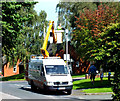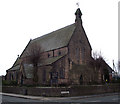1
Changing the light bulb
The gentleman standing in the cherry-picker is changing the bulb in the street-light on Galbraith Close. He has gained himself a bit of an audience, and the small gentleman on the right looks as if he might consider this to be his future career- especially as steam engine drivers are no longer required very often.
Image: © Jonathan Kington
Taken: 2 Sep 2011
0.09 miles
2
Down the hill
Having reached the top of hill in
Image the path descends to Astbury Street and Galbraith Close on the edge of Congleton.
Astbury Mere was originally a sand quarry, in 1984 operations ceased and the quarry closed. For over 50 years the local residents had put up with a noisy major industry on their doorsteps, wildlife started to gain a foothold and it was thought that the area might become a local amenity. But a proposal was put forward to construct a major industrial complex on the site. Dismayed, the locals set up an action group to fight the proposals and intensive negotiations were started. After years of uncertainty the landowners agreed to sub divide their estate; half the site would instead be developed for housing whilst the remainder would be given over as open space and so began the creation of Congleton’s first Country Park. The action group then became the Astbury Mere Trust, a registered charity and a limited company whose main objectives are to: “Provide for the benefit of the inhabitants of Congleton and district a managed and maintained country park at Astbury Mere in perpetuity for recreation or other leisure time occupation with the object of improving the conditions of life for the said inhabitants”. Since its opening in 1989 the Country Park has become a valued recreational resource for the inhabitants of Congleton and beyond. In this time the Park has matured, not only in physical terms with the growth of trees and shrubs but also in its evolution as an important outdoor recreational and learning resource. Although still owned by the Trust, Astbury Mere Country Park is managed by Cheshire East Council ( http://www.cheshireeast.gov.uk/leisure,_culture_and_tourism/ranger_service/countryside_sites/congleton_area/astbury_mere_country_park.aspx ).
My thanks to Matthew Axford, Countryside Ranger, for providing a much more detailed history than there was space for here.
Image: © Jonathan Kington
Taken: 2 Sep 2011
0.11 miles
3
Entering the park
Entering Astbury Mere Country Park from the entrance at the end of Astbury Street.
Astbury Mere was originally a sand quarry, in 1984 operations ceased and the quarry closed. For over 50 years the local residents had put up with a noisy major industry on their doorsteps, wildlife started to gain a foothold and it was thought that the area might become a local amenity. But a proposal was put forward to construct a major industrial complex on the site. Dismayed, the locals set up an action group to fight the proposals and intensive negotiations were started. After years of uncertainty the landowners agreed to sub divide their estate; half the site would instead be developed for housing whilst the remainder would be given over as open space and so began the creation of Congleton’s first Country Park. The action group then became the Astbury Mere Trust, a registered charity and a limited company whose main objectives are to: “Provide for the benefit of the inhabitants of Congleton and district a managed and maintained country park at Astbury Mere in perpetuity for recreation or other leisure time occupation with the object of improving the conditions of life for the said inhabitants”. Since its opening in 1989 the Country Park has become a valued recreational resource for the inhabitants of Congleton and beyond. In this time the Park has matured, not only in physical terms with the growth of trees and shrubs but also in its evolution as an important outdoor recreational and learning resource. Although still owned by the Trust, Astbury Mere Country Park is managed by Cheshire East Council ( http://www.cheshireeast.gov.uk/leisure,_culture_and_tourism/ranger_service/countryside_sites/congleton_area/astbury_mere_country_park.aspx ).
My thanks to Matthew Axford, Countryside Ranger, for providing a much more detailed history than there was space for here.
Image: © Jonathan Kington
Taken: 2 Sep 2011
0.13 miles
4
St. Mary's Roman Catholic Chapel, Congleton
Image: © nick macneill
Taken: 1 Sep 2011
0.13 miles
5
A34 West Road
Heading west at Congleton
Image: © Kenneth Allen
Taken: 30 May 2012
0.14 miles
6
Congleton, West Road
Image: © David Dixon
Taken: 17 Jul 2014
0.15 miles
7
Hawthorn berries
Spring of 2011 produced a very bright show of Hawthorn flowers and now Autumn is showing an extremely heavy crop of berries, an excellent food source for the birds in the coming Winter.
The Common Hawthorn (Crataegus monogyna), often called May, is a native shrub to the UK and is often used as a hedging plant. They mostly grow from between 5 and 15 metres tall and have white, sometimes pink, flowers followed by red berry-like fruits (commonly known as Haws) produced on thorny branches. Ecologically, Hawthorns are very important in that they provide food and shelter for small birds and mammals, especially when grown as hedges. The flowers provide a nectar source for many invertebrates and a large number of Butterfly larvae feed on the shrub. During the winter the berries provide food for a number of species of birds, particularly thrushes and waxwings who eat the berries and disperse the Hawthorn seeds in their droppings. Hawthorn flowers are reputed to have magical properties, and are believed to bring about a death in the family if they are taken into the home. This may have something to do with the trimethlamine present in the flowers - this substance is one of the first products formed when body tissue starts to decay. Hawthorn is also said to have been the source for Christ's crown of thorns. During the First World War, the young leaves were used as a substitute for tea and tobacco, with the seeds being ground as a substitute for coffee
Image: © Jonathan Kington
Taken: 2 Sep 2011
0.16 miles
8
Postbox on Booth Street
This George V post box is located opposite the end of
Image
Image: © Jonathan Kington
Taken: 20 Mar 2011
0.16 miles
9
Church of St James the Great
Looking at the north and west elevations.
The first stone to be laid in the building of the Church of St James the Great was done by the then High Steward of the Borough of Congleton, Randle Wilbraham Esq, in May of 1847. The architect was James Trubshaw of Newcastle under Lyme; the chief contractor was Samuel Faram of Odd Rode with the woodwork being under the direction of Edward Massey of Lawton. The building work was paid for by public subscription along with grants from the Chester Diocesan Society, the Incorporated Society and the Church Commissioners. It is built in the style of the transitional period of Early English; this is evident in the steep roof that forms an equilateral triangle to the windows and doorways. The church is built of local, Cloud-side, gritstone with a Westmoreland slate roof. The church was consecrated by the Bishop of Chester Dr Graham on Wednesday 27th January 1849
Image: © Jonathan Kington
Taken: 20 Mar 2011
0.16 miles
10
Up the hill
After climbing the steps in
Image and
Image we have a gentle incline to the top of the hill, eventually reaching Astbury Street and Galbraith Close on the edge of Congleton.
Astbury Mere was originally a sand quarry, in 1984 operations ceased and the quarry closed. For over 50 years the local residents had put up with a noisy major industry on their doorsteps, wildlife started to gain a foothold and it was thought that the area might become a local amenity. But a proposal was put forward to construct a major industrial complex on the site. Dismayed, the locals set up an action group to fight the proposals and intensive negotiations were started. After years of uncertainty the landowners agreed to sub divide their estate; half the site would instead be developed for housing whilst the remainder would be given over as open space and so began the creation of Congleton’s first Country Park. The action group then became the Astbury Mere Trust, a registered charity and a limited company whose main objectives are to: “Provide for the benefit of the inhabitants of Congleton and district a managed and maintained country park at Astbury Mere in perpetuity for recreation or other leisure time occupation with the object of improving the conditions of life for the said inhabitants”. Since its opening in 1989 the Country Park has become a valued recreational resource for the inhabitants of Congleton and beyond. In this time the Park has matured, not only in physical terms with the growth of trees and shrubs but also in its evolution as an important outdoor recreational and learning resource. Although still owned by the Trust, Astbury Mere Country Park is managed by Cheshire East Council ( http://www.cheshireeast.gov.uk/leisure,_culture_and_tourism/ranger_service/countryside_sites/congleton_area/astbury_mere_country_park.aspx ).
My thanks to Matthew Axford, Countryside Ranger, for providing a much more detailed history than there was space for here.
Image: © Jonathan Kington
Taken: 2 Sep 2011
0.16 miles











